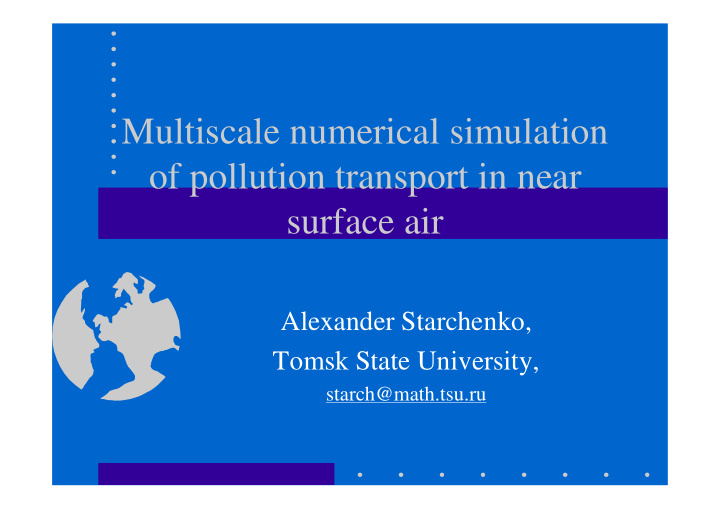



Multiscale numerical simulation of pollution transport in near surface air Alexander Starchenko, Tomsk State University, starch@math.tsu.ru
NWP & AQ simulation Nowadays a broad range of problems of atmospheric physics, climate and environment protection is solved with application of mathematical modelling approach. Modelling systems, developed at large centres of atmospheric research, are applied for scenario analysis, weather prediction, air quality investigation. For example, CMAQ, Community Multiscale Air Quality Chemical Transport Modelling System; EURAD, EURopean Acid Deposition model, EZM, European Zooming Model. Dynamic core of such systems are or well-known models (e.g. MM5, WRF) either original models.
Nesting technology One-nested Т о м с к Т о м с к Two-nested А н ж е р о - С у д ж е н с к А н ж е р о - С у д ж е н с к Ю р г а Ю р г а К е м е р о в о К е м е р о в о Tomsk Region Tomsk City Domain 50x50 km 2 Domain 200x200km 2
MM5 (Mesoscale Model 5) The PSU/NCAR mesoscale model is a limited-area, nonhydrostatic or hydrostatic, terrain-following sigma- coordinate model designed to simulate or predict mesoscale and regional-scale atmospheric circulation. It has been developed at Penn State and NCAR as a community mesoscale model. The Fifth-Generation NCAR / Penn State Mesoscale Model (MM5) includes a multiple-nest capability, nonhydrostatic dynamics, which allows the model to be used at a few-kilometer scale, multitasking capability on shared- and distributed-memory machines, a four-dimensional data-assimilation capability, more physics options.
Mesoscale Model 5 MM5 generates meteorological fields: - horizontal and vertical wind components, - pressure, - temperature, - air humidity, - cloudiness and precipitation parameters, - heat, moisture and momentum fluxes, - short-wave and long-wave radiation.
The Weather Research and Forecast Model is a next-generation mesocale numerical weather prediction system designed to serve both operational forecasting and atmospheric research needs. It features multiple dynamical cores, a 3-dimensional variational (3DVAR) data assimilation system, and a software architecture allowing for computational parallelism and system extensibility. The WRF model is a fully compressible, nonhydrostatic model. Its vertical coordinate is a terrain-following hydrostatic pressure coordinate. Model uses the Runge-Kutta 2nd and 3rd order time integration schemes, and 2nd to 6th order advection schemes in both horizontal and vertical directions. The dynamics conserves scalar variables.
The WRF model is designed to be a flexible, state-of-the-art atmospheric simulation system that is portable and efficient on available parallel computing platforms. WRF is suitable for use in a broad range of applications across scales ranging from meters to thousands of kilometres, including: - Idealized simulations (e.g. LES, convection, baroclinic waves) - Parameterization research - Data assimilation research - Forecast research - Real-time NWP - Coupled-model applications - Teaching
MM5 & WRF Since the MM5&WRF modeling system are primarily designed for real-data studies/simulations, it requires the following datasets to run: - Topography, landuse and vegetation (in categories); (1 o - 30’’ resolution) - Gridded atmospheric data that have at least these variables: sea-level pressure, wind, temperature, relative humidity and geopotential height; and at these pressure levels: surface, 1000, 850, 700, 500, 400, 300, 250, 200, 150, 100 mb; - Observation data that contains soundings and surface reports (final analysis data NCEP or ECMWF, global data NCEP)
Simulation cases Two temporal periods: 16-17 May 2004; 20-21 October 2004; Three local nested domains with horizontal sizes 450 х 450, 150 х 150 и 50 х 50km 2 . South of Western Siberia, Tomsk (56,5 o N, 85 o E) is in the centre of domains; Initial state of atmosphere and lateral boundary conditions were set up on the basis of NCEP final analysis data
Tomsk (56,6N; 85,0E)
Simulation conditions D1 D1 D2 D2 D3 Tomsk D3 Kemerovo Kemerovo Novosibirsk Novosibirsk Three nested domains D1, D2, D3 and distribution of landuse categories
Geographic map and land use distribution Tomsk Kemerovo Kemerovo Novosibirsk Novosibirsk Color table of land use categories in domain 450x450km: Color table of land use categories in domain 450x450km: blue- -water, water, violet violet- -few vegetation, few vegetation, yellow yellow- -farmland, farmland, light green light green- -deciduous forest, deciduous forest, brown brown- -mixed forest, mixed forest, blue green- -evergreen forest, evergreen forest, red red- -urban area urban area green
Terrain elevation map 450km x Tomsk x 450km
Land use categories for the research domain r. Tom Water Water Water Few vegetation Few vegetation Farmland Deciduous forest Mixed forest Evergreen forest Tomsk Urban area Tomsk city 50x50 km 2
Recommend
More recommend